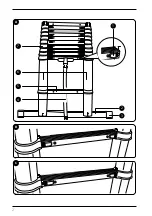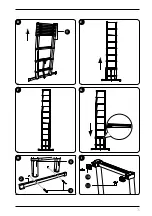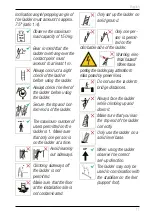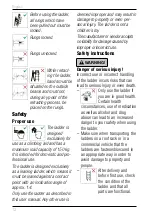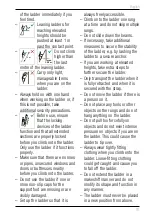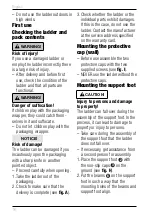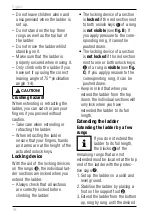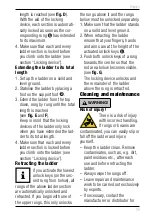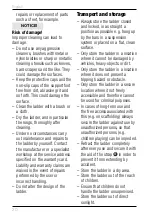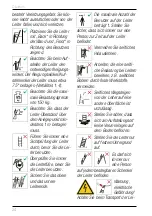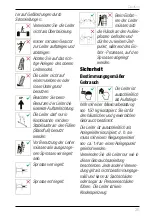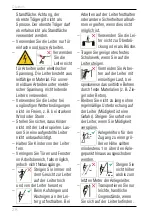
English
14
–
max.
kg
150
Never exceed the
payload of the ladder.
The maximum load-
bearing capacity of the
ladder is 150 kg.
–
Do not lean too far out
from the ladder when
you are standing on it.
You should always stand firmly
with both feet on the same step
and keep the centre of your body
(belly button) between the
beams.
–
Under no circumstances climb off
the ladder at great height without
an additional safeguard. Secure
the ladder or use a suitable
mechanism for securing the
stability.
–
3
2
1
Do not stand on the
top three rungs of the
ladder. Attention, the
top bar is not considered a rung.
The top bar may also not be used
as stepping surface.
–
Only use the ladder for simple
tasks that do not take much time
to complete.
–
Do not use
the ladder
to perform
work under electrical voltage. The
ladder is made of conductive
material. Use non-conductive
ladders for unavoidable live
electrical work.
–
Do not use the ladder outdoors
during adverse weather
conditions, e.g. strong wind or
storm.
–
Ensure that children do not play
with the ladder. Do not leave the
ladder unsupervised when it is
set up.
–
Keep children away from the
ladder.
–
If possible, lock all doors and
windows in the work area, but
not emergency exits.
–
Always climb up and
down the ladder with
your face to the ladder.
–
Keep a secure grip on
the ladder when
ascending and
descending. Maintain a handhold
whilst working from a ladder or
take additional safety precautions
if you cannot.
–
Do not use the ladder
to bridge distances or
as a bridge.
–
Wear suitably sturdy shoes when
you climb onto the ladder.
–
Avoid working on the
ladder with a one-
sided load, e.g. drilling
sideways through solid materials
(e.g. bricks or concrete).
–
Do not remain too long on the
ladder without regular pauses
(tiredness is a danger). Climb off
Summary of Contents for 7063596
Page 2: ...2 A B C 2 4 5 6 1 3 7...


